Learn Growing Carrots in Containers with tips on soil, light, water, and Carrot Care In Pots for a successful harvest.
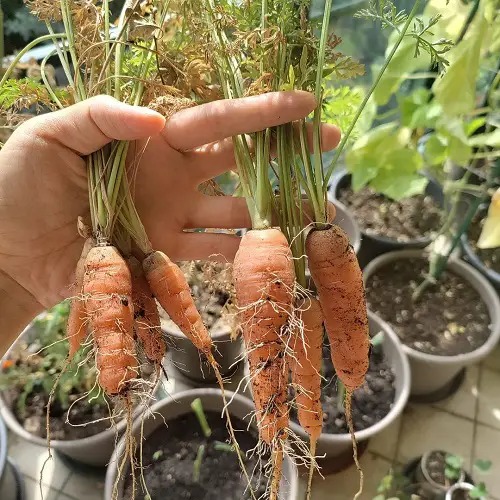
Carrots are a popular and nutritious vegetable that can easily be grown in pots, making them an ideal option for those who have limited space for a garden. Whether you live in an apartment with a balcony or have a small patio, growing carrots in pots is a simple and rewarding task. In this comprehensive guide, we will give you the Carrot Care In Pots tips and tricks you need to know about Growing Carrots in Containers.
Read everything you need to know about growing carrots
Best Planting Time for Growing Carrots in Containers
- Carrots are a hardy crop that can thrive in a variety of climates, from USDA Zones 3 to 11. To maximize your crop yield, it’s important to plant carrots at the right time.
- In cooler climates, you can start planting carrot seeds 2-3 weeks before the expected last frost date and continue planting every 2-3 weeks for a steady harvest throughout the growing season. This planting should continue until about 6-8 weeks before the average first frost date.
- However, if you live in a hot climate within USDA Zones 9b-11, it’s best to wait until the weather cools down, such as in the fall or winter, to plant your carrots. This way, they can grow without the stress of the hot summer weather.
- By planting seeds successively every few weeks, you can ensure a continuous supply of fresh carrots throughout the growing season.
Tip: Sow carrot seeds every 2-3 weeks successively for a fresh regular harvest all growing season.
Check out our article on Best Strawberry Companion Plants
Best Pot Size for Growing Carrots in Containers
Container size (6-15 inches deep) may vary according to the carrot type you’re growing and the planting depth it requires.
Choose a pot that is at least 10-12 inches deep and as wide as possible can be used to grow most carrot varieties. You can use pots, tubs, planter bags, and window boxes to grow this root vegetable.
Varieties of Carrot Suitable for Containers
These are just a few of the many varieties of carrots that can be grown in containers. When choosing a variety, consider your growing conditions, the size of your container, and your personal preferences.
1. Imperator 58
Imperator 58 is a long, slender variety of carrots that grows to about 8-10 inches long. They have a sweet and tender flavor and are well-suited for container gardening.
2. Parisienne
This is a small, round, and sweet-tasting variety of carrots that is ideal for container gardening. They grow to about 2-3 inches long and are ideal for pickling or use as baby carrots.
3. Nantes
Nantes is a long, cylindrical variety that is sweet and crisp. They grow to about 5-6 inches in length and are well-suited for container gardens because they don’t require a lot of depth.
4. Early Nantes
Early Nantes is a fast-growing variety of carrots that is ideal for container gardening. They grow to about 5-6 inches long and have a sweet and crisp flavor.
5. Minicor
Minicor is a miniature variety of carrots that grows to about 2-3 inches long. They have a sweet and crisp flavor and are ideal for container gardening because they are easy to grow and take up very little space.
6. Scarlet Nantes
This is a hybrid variety of Nantes that has a bright red color and is known for its sweet flavor. They grow to about 5-6 inches in length and are well-suited for container gardens.
7. Thumbelina
Thumbelina is a small, round variety of carrots that grows to about 2-3 inches long. They are sweet and crunchy and are ideal for container gardening because they don’t require a lot of depth.
8. Little Finger
Little Finger is a compact, round variety of carrots that grows to about 3 inches in length. They are sweet and crunchy and are ideal for container gardening because they are easy to grow and don’t take up a lot of space.
9. Danvers 126
This is a widely-adapted variety of carrots that grows well in containers. They are long and tapered, growing to about 6-7 inches long, and have a sweet and crisp flavor.
10. Chantenay
Chantenay is a squat, broad-shouldered variety of carrots that is ideal for container gardening. They grow to about 4-5 inches in length and are sweet and crunchy.
11. Rainbow Blend
This mixes different carrot varieties in various colors, including orange, purple, yellow, and white. They are all sweet and crisp and grow well in containers.
12. Lunar White
Lunar White is a unique variety of carrots with a pure white color and a sweet and crisp flavor. They grow well in containers and are a fun and interesting addition to any container garden.
13. Atomic Red
This is a unique variety of carrots with a bright red color and a sweet and spicy flavor. They grow well in containers and are a fun and attractive addition to any container garden.
14. Round St. Valery
Round St. Valery is a small, round variety of carrots that grows to about 1-2 inches in length. They have a sweet and crunchy flavor and are well-suited for container gardening.
15. Short & Sweet
Short & Sweet is a compact variety of carrots that grows to about 3-4 inches long. They have a sweet and crunchy flavor and are well-suited for container gardening because they are easy to grow and don’t take up a lot of space.
How to Grow Carrots in Containers
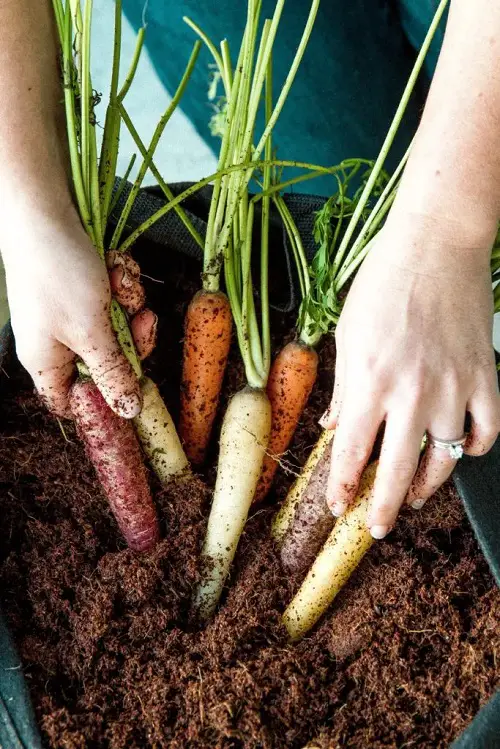
Once you’ve selected the carrot type you’re growing, gather the desired pots and fill them up with quality potting soil. Sow seeds 0.25-0.5 inches deep.
After germination, thin carrot seedlings (when they’re 2 inches tall) to about 2-3 inches apart. For thinning, instead of uprooting the baby plants, cut them using scissors so as not to disturb the roots of adjacent plants.
Requirements for Growing Carrots in Containers
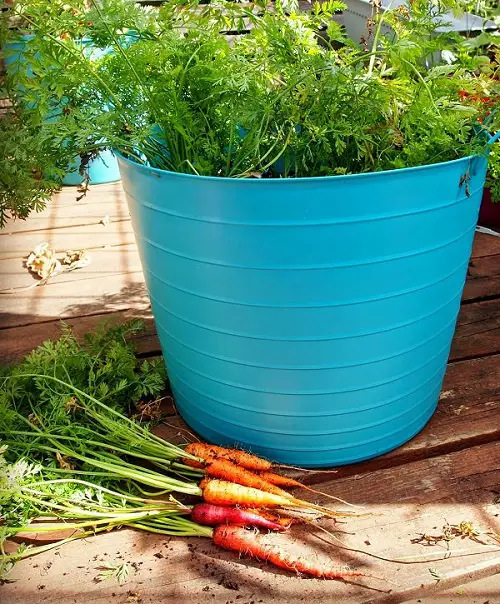
Location
Carrots require at least 6-8 hours of direct sunlight and 8-10 hours of indirect sunlight each day to grow to their full potential. However, in warm climates, you can keep your carrot plants in partial sun.
In colder regions, growing carrots in a less sunny position result in slow growth.
Soil
Carrots prefer well-drained, loamy, and aerated soil that doesn’t obstruct root growth. You can either buy quality potting soil for containers or make your own.
Ensure the prepared soil is more sandy than clayey and has no stones, or your carrots will be crooked and bent. The soil should be slightly acidic to slightly alkaline, pH range from 5.5-7.5. Ideally, 6-6.8.
Prepare your own potting mix by adding 1 part soil, 1 part compost or well-rotted manure, and 1 part perlite. If you want to make a soilless mix, add 1 part peat moss or coco peat, 1 part compost or well-rotted manure, and 1 part perlite, vermiculite, or sand. You can also add time-based fertilizer that is low in nitrogen when mixing the soil.
Watering
Maintain an adequate water level constantly. Water regularly and evenly to keep the soil slightly moist.
Check the soil moisture level with your finger to see if the medium is drying before watering, and never allow the soil to dry out completely. However, refrain from overwatering and waterlogging the pots.
In the end, when your carrot roots are about to mature (after 3/4 of their mature size), reduce the frequency of watering as too much moisture at the maturing stage leads to growth cracks in carrots.
Temperature
The seed germination temperature for growing carrots is between 42-90°F or 5-32°C, and the optimum seed germination temperature is between 55-75°F or 12-24°C. Carrot seeds usually germinate in the time frame of 1-3 weeks, much slower in low temperatures.
Best-tasting carrot roots are grown when the temperature ranges around 60-72°F or 15-22°C during the growing period. As you’re growing carrots in pots, you can adjust the temperature slightly by moving the containers to shade if the weather is warm and in more sun if the weather is cold.
Thinning and Spacing
Thinning and spacing are essential when growing carrots. The correct amount of space between carrot plants allows each plant to grow without overcrowding, which can result in stunted growth.
The ideal spacing is two to three inches apart when sowing seed. When the seedlings have grown to a height of two to three inches, they should be thinned to three to four inches apart. This ensures that the carrots have enough room to grow and develop normally.
To thin the carrots, grab the seedlings at the base and pull gently. If the soil is dry, water the area before thinning. Make sure to leave the strongest seedlings and discard the weaker ones.
Check out13 Easy DIY Seedling Greenhouse Ideas
Carrot Plant Care

Fertilizer
As carrots are a root crop, they don’t prefer soil that is high in nitrogen. To encourage root growth, use a fertilizer that is low in nitrogen but high in phosphorous and potassium.
For example, a formula of NPK 5-10-10. It’s a good idea to add time-based fertilizer or aged manure to the potting soil initially. Also, during the midseason, scrape some topsoil and side-dress with compost or well-rotted manure.
If you’ve not added anything to the soil, feed the carrots with liquid fertilizer biweekly according to the product’s instructions. You can also make your own organic liquid fertilizer from compost or manure, which is also called “Compost Tea.”
Pests and Diseases
Weeds, pests, and diseases impede the growth of carrot plants on the ground. However, in containers, you don’t need to worry about them as much. Aphids, spider mites, and flea beetles can disturb the growth but can easily be controlled because growing in a small area means you can easily identify the threat and take measures. Spraying insecticidal soap or neem oil after the early signs of an infestation is a nice chemical-free way to eliminate carrot pests.
Here are Free Seeds That You Can Find in Your Fridge or Pantry
Harvesting Carrots

Harvest carrots in late spring or early summer when the weather is mild. Carrots should be harvested when they are at least 1 inch in diameter.
To harvest, use a garden fork to loosen the soil around the carrot, and then use your hands to pull it out carefully. For the best taste and texture, leave the carrot on the ground until you are ready to use it.
After harvesting, brush off any excess soil and store them in a cool, dark place. Before digging all of them, see whether your carrots have reached the desired size or not by uprooting a couple of plants.


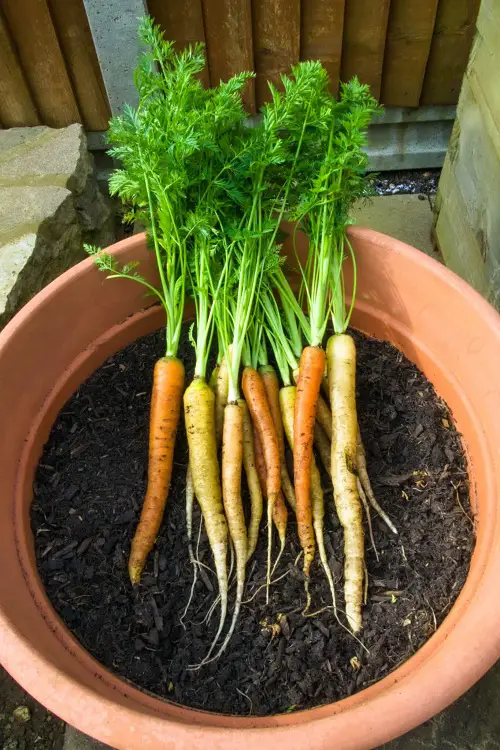
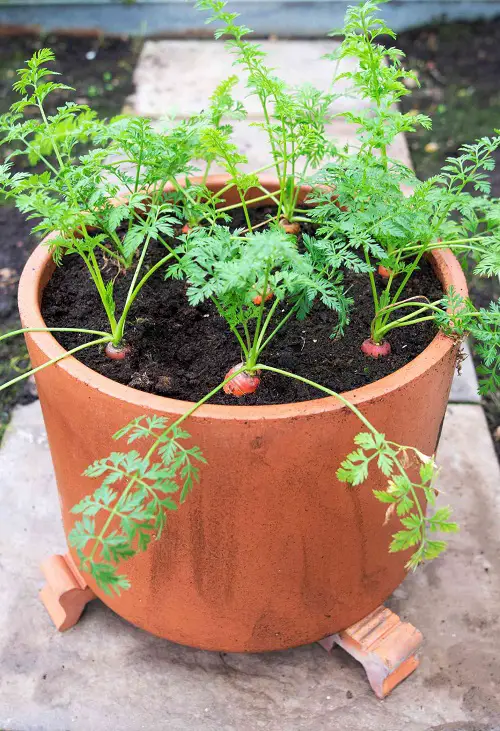

I would like to know more about growing carrots. Please advise me